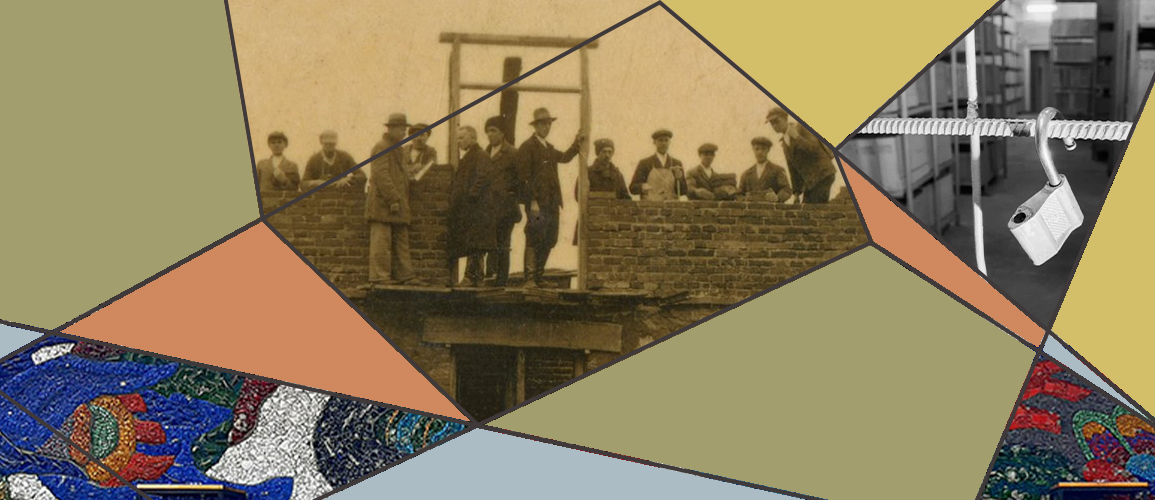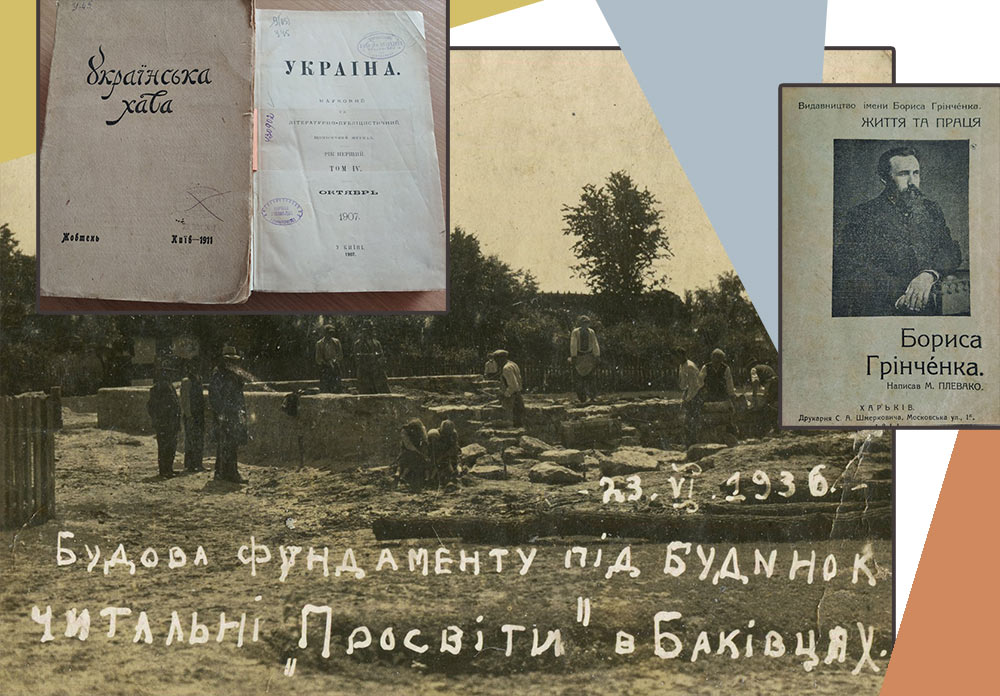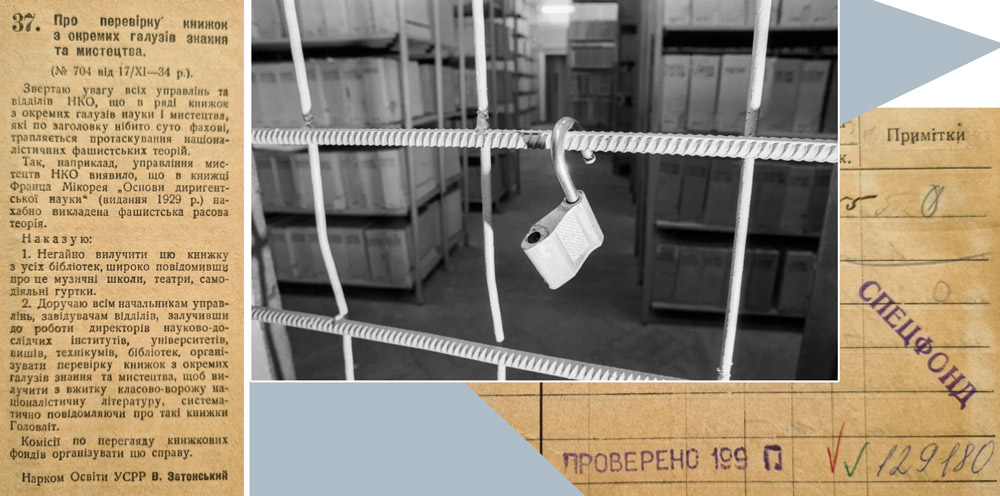Destruction of libraries
How to colonize libraries: a guide from Soviet practitioners
The communist authorities always paid close attention to librarianship, viewing it as a powerful tool for shaping public opinion. From the earliest days of the Soviet Union, nearly all public libraries operated under the control of state agencies responsible for “political education,” the most common euphemism for indoctrination.
All librarians followed instructions issued by Moscow, the political and ideological center of the USSR. In Soviet times, Russia subjugated Ukrainian libraries — today the country physically tries to destroy them.
Proofreading: Terra Friedman King
Creeping Russification
While the authorities publicly declared loyalty to the ideas of “equality of national languages and cultures,” in reality, they pursued a covert policy of gradual Russification across all spheres of life. Even the policy of “nativization” — a strategy that involved loyal representatives of the native populations of Soviet republics and autonomous regions in local governance and granted official (and sometimes dominant) status to their national languages — was a short-lived, tactical maneuver.
In the Ukrainian Soviet Socialist Republic, this policy, branded as “Ukrainization,” was implemented in 1923
but abandoned less than seven years later, once public trust in the Bolshevik government had been sufficiently bolstered.
The Russification of Ukraine’s libraries also took the form of a creeping and long-term process. It exercised various methods, from the mandatory use of Russian in library documentation to the overwhelming presence of Russian-language publications in collections, and the overt promotion of Russian culture and literature within these institutions.
“Purges” of Ukrainian Collections
The Russification processes imposed on Ukrainian libraries notably employed the removal of books deemed undesirable by authorities. Continuous campaigns purged the collections of Ukrainian libraries, starting in the early 1920s. These campaigns, altogether an unofficial form of censorship, controlled both the content and language of the collections. In this process, “political educators” and Golovlit, the Ukrainian SSR’s branch of Glavlit, or Directorate for the Protection of State Secrets in the Press, worked closely together.
Golovlit was the state censorship body that first emerged in the Russian Soviet Republic, later becoming an all-Union body in 1933. It existed until the collapse of the Soviet Union.
The clearest example of how this worked involved the fate of hundreds of libraries belonging to the Ukrainian cultural and educational society “Prosvita.” These libraries were stocked with Ukrainian-language publications that helped spread knowledge of the achievements of Ukrainian literature among the public, and continued to operate even after the defeat of the Ukrainian Revolution in 1921.
However, by the end of 1922, almost none of these institutions remained in Ukraine. Most of their collections were either destroyed or recycled into waste paper.
Dispersal of Library Collections
Another common practice was to disperse collections of distinctly Ukrainian publications among several libraries, destroying their integrity as historical and cultural artifacts.
This happened in the 1920s and 1930s to several prominent collections: the private library of writer, scholar and public figure Borys Hrinchenko, which he amassed over two decades; the library of the Kyiv affiliate of the “Prosvita” Society; the unique collection of Ukrainian books gathered by General Pavel Potocki, which he transported from St. Petersburg to Kyiv; the Shevchenko Scientific Society’s Ukrainian studies library in Lviv, the largest in western Ukraine; and other individual and institutional collections.
Seizure of Hostile Literature
From the 1920s onward, commissions of “politically reliable” individuals acting on circulars and proscription lists issued by political education and censorship departments routinely inspected library collections. They removed works deemed “hostile to the working class,” “counter-revolutionary,” or “harmful” to Soviet ideology.
Often, books were seized solely because they were
written by Ukrainians or in the Ukrainian language.
The works of many writers from the “Executed Renaissance” generation and victims of the Great Terror—such as Mykola Zerov, Hryhorii Kosynka, Serhii Yefremov, Mykola Khvylovy, Geo Shkurupii, Oleksa Vlyzka, Mykhailo Drai-Khmara, Mykola Kulish, Antin Krushelnytsky, and Maik Yohansen — were almost entirely purged from libraries.
“The Struggle Against Bourgeois Nationalism”
Authorities often justified the destruction of books under the pretext of furthering the “struggle against Ukrainian bourgeois nationalism.” This made-up term became a tool for suppressing national consciousness and was applied to anything that opposed the Soviet regime’s objectives. Works by authors critical of communist ideas or who distanced themselves from politics—including such dissidents as the Sixtiers, and Ukrainian diaspora writers—were banned and removed. The works of those who failed to adhere to the class-based approach or “socialist realism,” or who displayed too much national pride, also vanished from the shelves.
Even well-known figures in Ukrainian literature, like Volodymyr Sosiura, Maksym Rylsky, Ostap Vyshnia, Oles Honchar, Vasyl Stus, Vasyl Symonenko, and Oles Berdnyk, faced harsh criticism. Authorities would often force librarians to remove works by persecuted authors from user-facing shelves and hide them.
Moscow also denied many Ukrainian writers and scholars the right to publish, forcing them to write privately or distribute their works through “samvydav” (self-publishing), a method of clandestinely copying and circulating typewritten texts.
This suppression of Ukrainian literature led to Russian-language
publications dominating bookstores and libraries.
Special Storage
Another method of restricting access to politically and ideologically banned books was to create special storage units. Many Soviet libraries established such rooms, particularly in scientific institutions. These restricted book collections for special use (known as “spetsskhovy”) housed censored publications that the authorities considered a threat to their totalitarian regime. A book could be placed in these restricted archives for reasons as simple as labeling the author an “anti-Soviet element” or for containing critical remarks about party leaders or socialist practices.
These special collections existed for over 60 years, from the early 1920s until the late 1980s.
Ordinary readers were prohibited from accessing these collections, and few people were even aware of their existence, as the rooms in which they were housed were unmarked. Unsurprisingly, the majority of the books in these archives were Ukrainian “nationalist” publications. Ideological bodies in the Ukrainian SSR, including the Republican Committee for State Security and Ukrainian Golovlit, zealously served Moscow by actively seeking out and suppressing “anti-Soviet” content, including in books and libraries.
For instance, in the postwar period, some Ukrainian bibliographers were
persecuted for including works by banned authors in their indexes.
These indexes were withdrawn from circulation, and published copies were destroyed.
It is telling that no concept of “Russian nationalism” existed for Russian-language authors, who were free to glorify their country without restriction.
“Library Collectors”
Special units within book trade organizations, known as “library collectors,” also played a role in the Russification of library collections. Following the government’s book publishing policies, these units routinely imposed Russian-language publications on libraries.
If libraries wished to acquire popular Ukrainian-language books,
they had to accept mandatory “supplements” of Russian-language materials,
often filled with propaganda narratives.
Russian Priority
The book publishing policies of the totalitarian state prioritized Soviet publishing houses concentrated in Moscow, which published exclusively in Russian. These publishers enjoyed the greatest freedom in shaping their editorial portfolios, securing funding, and commissioning works from prominent figures.
They enjoyed access to powerful printing facilities in Russia and routinely translated popular foreign books into Russian. Ukrainian publishing houses could only translate some of these works from Russian translations if there was significant reader demand.
Furthermore, technical, medical, physical, mathematical literature, and even fiction, particularly from peripheral publishing houses like “Tavria” (Simferopol), “Donbas” (Donetsk), “Mayak” (Odesa), and “Karpaty” (Uzhhorod), were largely published only in Russian.
Although many books were published in Ukrainian, these could not compete with the multimillion-copy print runs of the Union’s Russian-language publications in terms of titles, circulation, or reader demand. Naturally, these disparities were reflected in the composition of library collections.
Methods of libraries colonisation
Ukrainian Libraries Today
The cumulative effect of the methods used to suppress Ukrainian books—subtle yet persistent—resulted in a paradoxical situation: in Ukraine, Russian-language publications often vastly outnumbered books in the native language in library collections, especially in some regions.
Authorities weaponized Russian-language literature, along with Soviet publications filled with ideological narratives, to sever Ukrainians from their national roots, historical memory, and cultural achievements. This undermined their mentality, fostering an inferiority complex and alienating them from their mother tongue.
Even 30 years after Ukraine’s independence, the impact of Russification, distorted library policies, and the echoes of Russian cultural and linguistic expansion on the country’s information space remain evident. Despite active efforts to de-Russify library collections, many still contain a significant number of Russian-language publications. Moreover, a considerable percentage of Ukrainians, including schoolchildren and youth, continue to use Russian in their daily lives. This situation is not merely a result of inertia in social and cultural processes.
Physical Destruction of Libraries (1)
Russia has now shifted its approach from subjugating libraries to outright destroying them in Ukrainian territories. Collections are being completely obliterated or replaced with ideological content in the occupied regions. Today, there are 11,901 libraries in Ukraine—17% fewer than before the large-scale invasion.
Libraries are closing not only in frontline regions but also in Dnipro, Zakarpattia,
Lviv, Odesa, Poltava, Sumy, Ternopil, Khmelnytskyi, Cherkasy, and Chernivtsi regions.
The statistics of libraries desctruction


As of June 2024, 175 public libraries have been completely destroyed in Ukraine, primarily in Donetsk, Zhytomyr, Zaporizhzhia, Sumy, Kharkiv, Kherson, Mykolaiv, and Chernihiv regions. Another 786 libraries have sustained various levels of damage, including partially destroyed buildings, roofs, ceilings, floors, windows, and doors.
However, libraries are not just damaged by shelling. After the de-occupation of territories in Sumy, Kharkiv, Kherson, and Chernihiv regions, numerous stories have emerged about what the occupiers left behind: mined buildings, utter disorder, broken furniture, stolen equipment, holes punched in walls, Ukrainian books piled in dumpsters and used as firewood, and desecrated national symbols.
The author: Serhii Zvorskyi, an employee of the Yaroslav
Mudryi National Library of Ukraine, PhD in History, Senior Researcher.
Translation: Victoria Pushyna
Copy editing: Ben Angel
- The section “Physical Destruction of Libraries” includes excerpts from material by Valentyna Zdanovska, chief librarian of the Yaroslav Mudryi National Library of Ukraine.
This article is a part of the special project ‘Erasure of a Word’ created in support of the exhibition ‘Antitext’. The project is implemented by the Chytomo media in cooperation with the Kharkiv Literary Museum.





